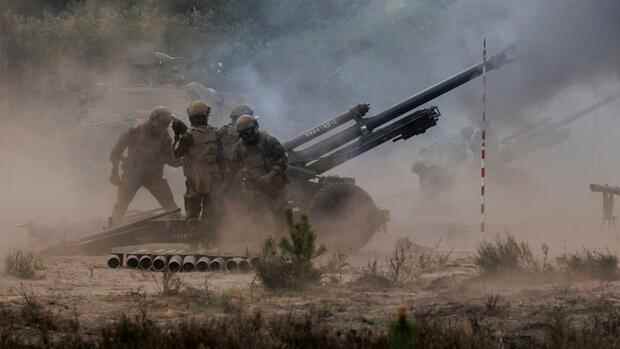Muenster The heath landscape lies quietly in the glistening morning sun, the view extends far over the open area. Suddenly there is lightning at the edge of the forest in the distance, a small mushroom of smoke rises, then comes the bang. Then another explosion and another.
A short time later there is a wall of smoke over the heath. If the enemy had been there, for example slowed down by a mine barrier, there would not be much left of him.
Here at the Munster military training area in Lower Saxony, a fictitious opponent is being fought, “red” against “blue”. In the “Wettiner Heide” exercise, around 7,500 soldiers from nine countries are preparing to provide the NATO Response Force (NRF) in the coming year. This rapid reaction force must be able to be deployed within days in a wide variety of crisis and conflict situations around the world.
Also on NATO’s eastern flank against an imperialist Russia? Artillery battalion commander Timo Kaufmann does not rule that out. “We are preparing for an equal opponent.” The troops are trained in such a way that they can be used in any conflict. But of course the Ukraine war is always in the back of the minds of the soldiers.
Top jobs of the day
Find the best jobs now and
be notified by email.
Next year, Panzergrenadierbrigade 37 “Freistaat Sachsen” will be the Bundeswehr’s lead unit for the NRF land forces. They then provide almost a third of the up to 12,000-strong ground force, the rest comes from other parts of the German army or the eight partner nations.
The exercise alone shows the enormous logistical effort that has to be made to have a powerful NATO spearhead ready. Within less than ten days, the forces from the Benelux countries, the Czech Republic, Scandinavia and the Baltic States were brought together, crossings over the Weser or the Elbe were rehearsed.
The commander of Panzergrenadierbrigade 37, Brigadier General Alexander Krone, emphasizes the challenge. “The trick here is the interaction of all parts,” he says. Above all, the logistics are practiced – supply, replenishment, repair of failed equipment.
A German brigade is to be the lead organization for the NRF forces in the coming year.
(Photo: Getty Images)
The next artillery salvo is being prepared in the Lüneburg Heath, a “Fennek” reconnaissance car drives up to record target data and then quickly withdraws again. Norwegian artillery spotters stand a few yards away, including Captain Karl Jonas Vandbakk of a unit named after the largest piranhaart piraya.
The cooperation works well, you work as a well-rehearsed team, says the soldier. But that is only the half truth. The Bundeswehr in particular has a bad reputation for not being up to the standard in terms of radio equipment, for example, which enables smooth interaction with other nations.
Brigade commander Krone also admits that there are friction losses. “In the ideal world, everyone always has the same thing and always makes a software and hardware update at the same time, then there are never any interface problems,” he says.
Bundeswehr soldiers train with a Panzerhaubitze 2000.
(Photo: Getty Images)
At the moment, however, the interface is often still the soldier on the swivel chair in the reconnaissance tank. He manually re-enters the data he received from a colleague in another NATO country into his own system. When it comes to interoperability, the goal has perhaps been achieved up to 50 percent, says Krone. “There’s always room for improvement here.”
Bundeswehr becomes visible again
The maneuver takes place in the Lüneburg-Hannover-Gifhorn triangle and is not limited to the military training areas. Soldiers camp on farms or are housed in the village community center in Burgwedel. The Bundeswehr is becoming more visible again. He hears from the older people in the villages that things like this were more common in the past, says Krone.
Earlier, that was the time of the Cold War, when Soviet tank attacks were still expected. Then came the hope of the peace dividend and the conversion of the Bundeswehr into an army specializing in foreign operations. With the Ukraine war there is now more tailwind for the troops, says Krone, while machine gun fire echoes over the training area.
The preparation of the NRF operation was not under a good star for the Panzerbrigade 37. Due to the pandemic, for example, there were restrictions on the accommodation of troop units that wanted to practice together. Krone also temporarily assigned 3,500 soldiers to Corona administrative assistance. There was no time for training. Krone hopes all the more that everything will work out now and that the multinational force he will lead will receive NATO certification.
More Handelsblatt articles on the subject:
So is the Bundeswehr better than its reputation if it can lead the land forces of the NATO Rapid Reaction Force in the coming year? The NRF status is something special, says battalion commander Kaufmann. “It would be nice if it were the same for the entire Bundeswehr.” There is a lot of catching up to do, for example in the supply of spare parts.
Of course, this should work in practice. The multinational supply battalion has set up one of three bases in the Hörsten camp on the Bergen military training area. A Panzerhaubitze 2000 has failed, the most important weapon of the artillery force, twelve of which Germany and the Netherlands want to supply to the Ukraine.
A “Buffalo” armored recovery vehicle immediately rolls up, and soldiers get to work on the almost 60-ton device. Lieutenant Colonel Sven Heidel, who commands the supply battalion, hopes that the weapon will be repaired within 48 hours at the latest. If the Bundeswehr wants to, then they can too.
More: The transformation of the Greens: Suddenly tank fans instead of pacifists
